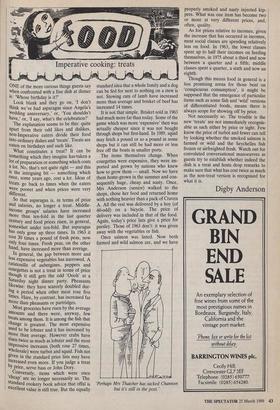Imperati ▪ ve cooki ▪ ng: treats ONE of the more curious
things guests say When confronted with a fine dish at dinner is: 'Whose birthday is it?' Look blank and they go on, don't think we've had asparagus since Angela's wedding anniversary,' or, 'You shouldn't have,' or, say, what's the celebration?' The explanation seems to be this: quite apart from their odd likes and dislikes, non-Imperative eaters divide their food into ordinary dishes and 'treats'. Treats are eaten on birthdays and such like. What constitutes a treat? It can be something which they imagine has•taken a lot of preparation or something which costs a lot. No, that's not quite right — and this is the intriguing bit — something which once, some years ago, cost a lot. Ideas of treats go back to times when the eaters were poorer and when prices were very different.
So that asparagus is, in terms of price and salaries, no longer a treat. Middle- income groups' salaries have increased more than ten-fold in the last quarter century and food prices risen, in general, somewhat under ten-fold. But asparagus has only gone up three times. In 1963 it cost 30 times a pound of fresh peas, now only four times. Fresh peas, on the other hand, have increased more than average. In general, the gap between more and less expensive vegetables has narrowed. A ratatouille of aubergines, peppers and courgettes is not a treat in terms of price though it still gets the odd 'Oooh' at a Saturday night dinner party. Pheasants likewise: they have scarcely doubled dur- ing a period when other meat rose five times. Hare, by contrast, has increased far more than pheasants or partridges. Most groceries have risen by the average amounts and there were, anyway, few treats among them. It is among the fish that change is greatest. The most expensive used to be lobster and it has increased by more than average. However crabs have risen twice as much as lobster and the most impressive increases (both rose 27 times, wholesale) were turbot and squid. Fish not given in the standard price lists may have increased even more. If you judge a treat bY price, serve bass or John Dory. Conversely, items which were once 'cheap' are no longer necessarily so. The standard cookery book advice that offal is excellent value is still true. But the equally standard idea that a whole family and a dog can be fed for next to nothing on a stew is not. Stewing cuts of lamb have increased more than average and brisket of beef has increased 14 times.
It is not that simple. Brisket sold in 1963 had much more fat than today. Some of the game which was more 'expensive' then was actually cheaper since it was not bought through shops but first-hand. In 1989, squid may fetch a pound or so a pound in some shops but it can still be had more or less free off the boats in smaller ports.
The items themselves change. When courgettes were expensive, they were im- ported and grown by nations who knew how to grow them — small. Now we have them home-grown in the summer and con- sequently huge, cheap and nasty. Once, Mrs Anderson (senior) walked to the shops, chose her food and returned home with nothing heavier than a pack of Craven A. All the rest was delivered by a boy (of 60-odd) on a bicycle. The price of delivery was included in that of the food. Again, today's price lists give a price for parsley. Those of 1963 don't: it was given away with the vegetables or fish.
Once salmon was listed. Now both farmed and wild salmon are, and we have 'Perhaps Mrs Thatcher has sacked Channon but it's still in the post.' properly smoked and nasty injected kip- pers. What was one item has become two or more at very different prices, and, often, quality.
As for prices relative to incomes, given the increase that has occurred in incomes, most social classes are spending relatively less on food. In 1963, the lower classes spent up to half their incomes on feeding themselves, in 1975 about a third and now between a quarter and a fifth; middle classes spent a quarter, a sixth and now an eighth.
Though this means food in general is a less promising arena for those bent on 'conspicuous consumption', it might be supposed that the emergence of particular items such as some fish and `wild' versions of differentiated foods, means there is always scope for showing off by price. Not necessarily so. The trouble is the new 'treats' are not immediately recognis- able as such either by price or sight. Few know the price of turbot and fewer can tell by looking whether the smoked salmon is farmed or wild and the Seychelles fish frozen or airfreighted fresh. Watch out for convoluted conversational manoeuvres as guests try to establish whether indeed the dish is a treat and hosts drop remarks to make sure that what has cost twice as much as the non-treat version is recognised for what it is.
Digby Anderson


















































 Previous page
Previous page